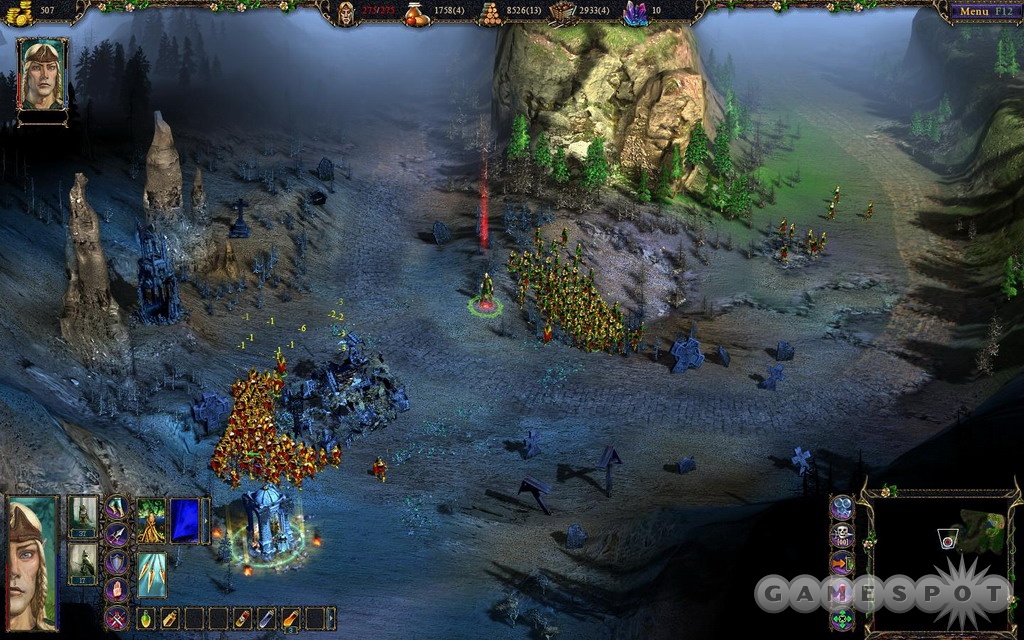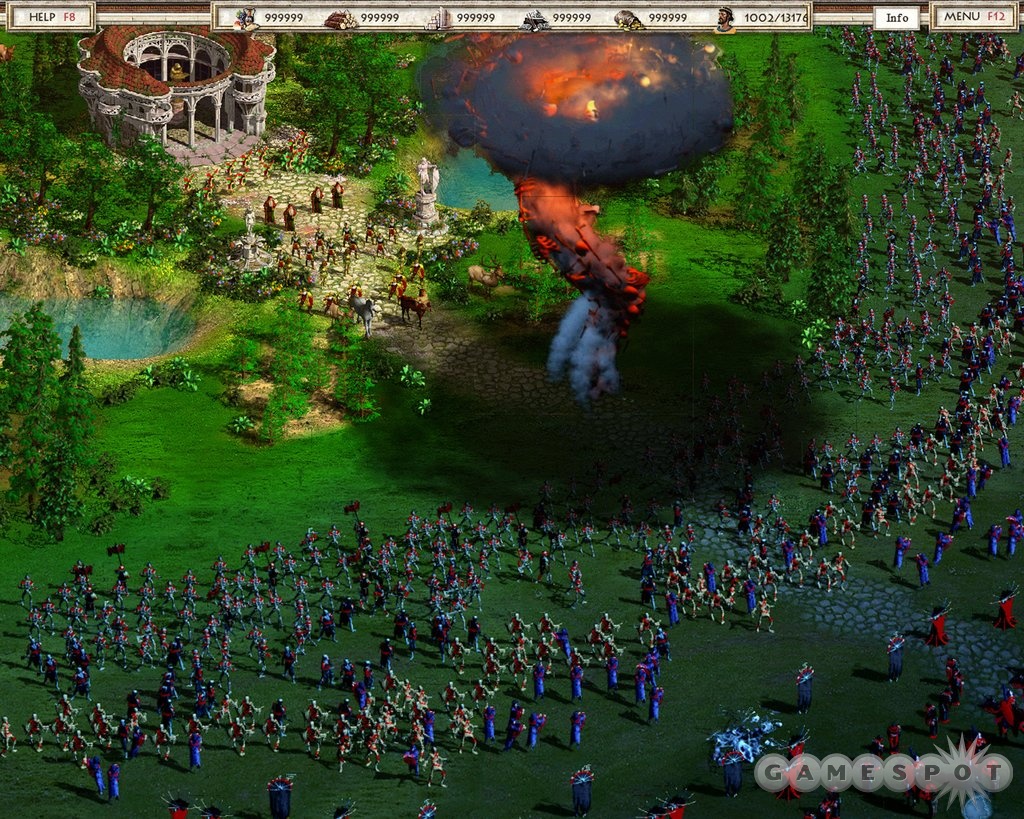It's hard not to wonder how good a hero you are if your empire is annihilated. Yet there's more amiss in GSC Game World's strategy/role-playing hybrid than its awkward title. Heroes of Annihilated Empires is pleasant but inelegant, clumsily cobbling together a mishmash of ideas in a congenial wrapper that's too friendly to hate and too half-baked to love. Every good idea is hobbled by poor execution, yet Heroes exudes an undeniable charm that tries hard to make up for a myriad of shortcomings. But in the end, it's just not enough to overcome broken features and a nagging suspicion that the game simply wasn't ready to be shipped.
Heroes of Annihilated Empires comes with a single campaign, and it features the Sylvan folk and the titular hero, Elhant. It's a little odd that there are empty slots in the campaign selection screen, as if there are two other campaigns to unlock. While apparently reserved for the two planned sequels, the slots are more than a little misleading and make the game feel unfinished. Thankfully, the single campaign is likable, even if it's mired in the decades of high fantasy that preceded it. We've all fought the legions of undead with our swords and bows in other games, and there's nothing inherently wrong with the conventional fairies, elves, and dwarves that populate Heroes. But there are hints of greater things to come that remain unexplained, such as the remains of a crashed jet fighter on a mountain top. If you're looking for some kind of intriguing science-fiction/fantasy crossover like the 2001 role-playing game Arcanum, you won't find it here, as the game forces you to wait for the next game in the series to be enlightened. Elhant is a fascinating and impetuous hero, though, and his strong voice acting carries the entire campaign. Yet you can't help but wonder why there are tank remnants in a land of pixies and enchanted forests, and the teasing final scene doesn't help matters.
The campaign does a good job of introducing you to Heroes' mixture of real-time strategy and role-playing game gameplay. On the role-playing side, your hero levels up, earns new spells, collects loot, and equips weapons and armor. Leveling is hardly a grind. It happens quickly, and before you know it you'll be earning stat and skill bonuses by killing goblins and zombies. Whenever you level up, you get a few bonuses to choose from, ranging from increases to your attack rate to a larger mana pool. If you don't like the choices, you can also choose to forego a bonus, and at the next level you'll get a more complete list of options. It's an adequate system, but because there is no skill tree to explore or professions to consider, the bonuses feel arbitrary and leveling up doesn't have the same addicting element that it would in a true RPG.
The strategy elements feel a little more fleshed out. Heroes of Annihilated Empires' claim to fame is that it supports approximately one zillion units onscreen at a time. Even in the first missions, you'll be attacked by swarms of the undead, and you'll be churning out hundreds and hundreds of your own units. Controlling all of them is a handful, yet the game does only a half-hearted job of helping you maintain your army. On one hand, you can set a building to continually produce a given type of unit, which is incredibly useful. On the other hand, there's no way to select idle workers and give them an appropriate chore. Additionally, while most modern-day RTSs do not include workers when you drag a selection box around units, Heroes does. Don't be surprised if you send your fragile worker fairies off with your centaurs by mistake. It's frustrating that a game with so many units doesn't make it easier to organize them.
When everything runs on all cylinders, it's good fun to send out a gang of golems or a mob of druids to confront the enemy forces head on. Encounters like these are chaotic in a good way, even if they require little in the way of real strategy. Battles boil down to throwing your big mess of units at your enemy's big mess of units, and then sending your hero in to clean it all up with a few spells. Yet as cool as it is to see all those tiny units swarming across your screen, it also makes it easy to notice just how brain-dead the artificial intelligence is. Sometimes, entire collections of units will try walking through a mountain to get to you and will continue to shuffle in place when you send another group in behind them. Other times, you will approach a cluster and they just sit there without so much as an idling animation, almost Zen-like in their stillness. It goes without saying that they won't try any fancy maneuvering like flanking; when the AI does function, the enemy just rushes you en masse.
The friendly AI is also wildly inconsistent. Your own units may take an unannounced lunch break during battle, choosing to watch from the sidelines. This behavior seems to mostly plague melee units, and it serves to highlight Heroes' biggest balancing issue: Ranged attacks are generally much more effective than close attacks, so a jumble of archers gets you farther than a jumble of swordsmen. And sometimes the combinations of poor AI make for problems so disastrous it's a wonder some missions made it past testing. For example, at one point you must kill a boss wizard who occasionally hurls a ghostly skull towards you. Attacking with your bow does only one point of damage, and you're meant to use your sword. Using it means you have to try to continually move out of the wizard's way to avoid his attack, but the overzealous hero AI keeps forcing your hero to rush after him, making the mission overly difficult. In the meanwhile, the wizard isn't smart enough to figure out that his skeletal projectile can't fly through objects. Thankfully, arrows can. The best solution to the frustrating task? Shoot arrows through solid rock, whittling him down one point at a time and turning the tough challenge into a cakewalk.
Outside of the campaign, you can also play the same artificial unintelligence in a skirmish match. Yet the game only ships with three maps, which means there are more playable skirmish races than there are game environments. You can play as the elves from the single-player campaign again, or choose the Mechanicians, Cryo, or the undead. The Mechanicians and Cryo sound cool but are just sand dwarves and ice dwarves, respectively. What makes skirmishes fascinating is that you can take the RPG route, play the match as an RTS, or work out a combination of the two. You start the game with your hero and can summon worker units to begin building a base--but if you do, the hero is frozen for an entire 30 minutes. Alternately, you can level up your hero and purchase the favors of nearby tribes, who will then ignore you but attack your enemy. They're both viable ways of playing, and the balancing is pretty good in spite of the potential difference in play styles.
Of course, you may prefer to play with another human being. Good luck with that. Heroes of Annihilated Empires works just fine over a local network, and it also lets you connect with a remote player via IP address. However, there's an intriguing "Internet game" option in the menu that even requires you to enter a game-box ID to create an online account. Choosing the option results in a screen that looks like an Internet game browser, but it doesn't actually function and eventually times out with a message that you are unable to connect with the server. The server browser will presumably be used in the future, but as of press time, it's busted.
Much of the game's appeal lies in the pretty and colorful land of Aquador, even if it isn't that technically impressive. The maps feature vibrant foliage, intricate architecture, and an obvious Tolkien-esque vibe. Units aren't very detailed, nor do they have a lot of animations, but the engine renders hundreds upon hundreds of them at a time with only the occasional drop in frame rate. Some of the spell effects are decent, although the majority of them are decidedly underwhelming. That mostly has to do with the nosebleed view the camera gives you. You can zoom in and out a tad, but even at the closest zoom level, you feel distanced from the action and much of the artistic beauty goes wasted.

A lot of credit for the world's allure goes to Elhant's strong voice-over. Most of the voice acting is quite good, with some hammy exceptions here and there. However, there is a gigantic and glaring flaw in the sound design: If you escape out of a conversation, the voice-over continues. In the case of the more laborious dialogues, like those with the slow-talking tree creatures, you'll move on to battle while the lengthy conversation plays out. Add in the generic soundtrack and repetitive cries from the dying forest folk, and you may be tempted to turn off the sound from time to time, just to give your ears a rest.
There's still something strangely compelling about Heroes of Annihilated Empires, with its throngs of units and an original take on the RPG/RTS mixture. But as good as it wants to be, it's crippled by its terrible artificial intelligence, poor multiplayer options, and half-baked design and story elements that make the game feel unfinished. It may be worth a passing glance to strategy fans looking for something different, but most players will find that playing hero to an obliterated kingdom isn't all that fulfilling.
